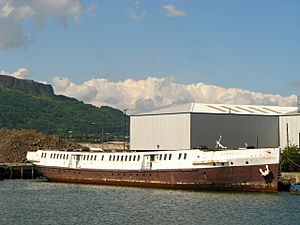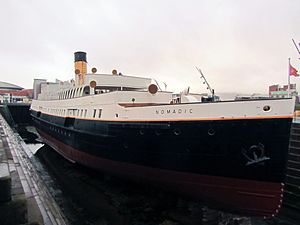SS Nomadic (1911) facts for kids
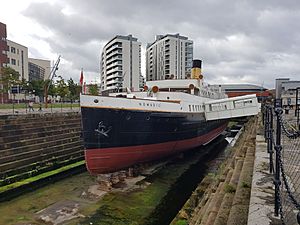
SS Nomadic converted into a museum ship in Belfast, 2018.
|
|
Quick facts for kids History |
|
|---|---|
| Name | SS Nomadic |
| Owner | |
| Operator | White Star Line |
| Port of registry | Cherbourg, France |
| Builder | Harland and Wolff, Belfast |
| Yard number | 422 |
| Laid down | 22 December 1910 |
| Launched | 25 April 1911 |
| Completed | 27 May 1911 |
| Acquired | 27 May 1911 |
| Maiden voyage | 31 May 1911 |
| Fate | Sold |
| Notes | Sea trials 16 May 1911 |
| Name | SS Nomadic |
| Operator | Compagnie Cherbourgeoise de Transbordement |
| Port of registry | Cherbourg, France |
| Acquired | 1927 |
| Out of service | 1969 |
| Renamed | Ingenieur Minard |
| Fate | Sold to UK |
| Name | SS Nomadic |
| Operator | SS Nomadic Charitable Trust Ltd. |
| Port of registry | Cherbourg, France |
| Acquired | 2006 |
| Identification | IMO number: 5161110 |
| Status | Museum ship, Belfast, County Antrim, Northern Ireland |
| General characteristics | |
| Tonnage | 1273 gross register tons |
| Length | 220 ft (67 m) |
| Beam | 37 ft (11 m) |
| Draught | 8 ft (2.4 m) |
| Decks | 5 |
| Installed power | 2 single-ended Scotch marine boilers |
| Propulsion | 2 double-expansion engines powering 2 triple-bladed propellers |
| Speed | 12 knots |
| Capacity | 1,000 passengers |
| Crew | 14 |
The SS Nomadic is a special ship with a long history. It was built to help the huge ocean liners, like the famous RMS Titanic and RMS Olympic. These giant ships were too big to dock in some harbors. So, the Nomadic would carry passengers and their luggage from the shore out to the liners.
The Nomadic was launched on April 25, 1911, in Belfast, Northern Ireland. Today, it is a museum ship in Belfast's Titanic Quarter. It is the only ship left that was designed by Thomas Andrews, who also designed the Titanic. It is also the only ship from the White Star Line that still exists.
Contents
Building the Nomadic
The White Star Line ordered the Nomadic in 1910. They needed it to serve their new, very large ocean liners, the Olympic and Titanic. These liners were so big they could not fit into the harbor at Cherbourg, France.
The Nomadic and its sister ship, SS Traffic, would carry passengers, their bags, mail, and supplies. They would take these items to and from the big ocean liners waiting offshore.
The Nomadic's construction started in 1910 at the Harland and Wolff shipyards in Belfast. It was built on slipway No. 1, right next to where the Olympic and Titanic were being built. The ship was launched on April 25, 1911. After some tests at sea, it was given to the White Star Line on May 27, 1911.
How the Ship Was Built
The Nomadic is about 70 meters (230 feet) long and 11 meters (37 feet) wide. It weighs 1,273 gross register tons. The ship was powered by two coal-fired boilers and two steam engines. These engines turned two propellers, each about 2 meters (7 feet) wide. This allowed the ship to travel at a speed of 12 knots (about 22 kilometers per hour or 14 miles per hour).
The Nomadic was made of steel, with a strong steel frame and riveted hull plates. It had four main decks and could carry up to 1,000 passengers.
Inside the Ship
The ship had lounges for passengers on its lower and upper decks. There were also open deck areas for people to enjoy the fresh air. The ship was divided into first-class and second-class areas. First-class passengers had the front part of the ship. A small area at the back was for extra third-class passengers from the Traffic.
The inside of the Nomadic was very fancy, just like the Olympic and Titanic. It had many luxuries that most other tender ships did not have. These included soft benches, tables, porcelain water fountains, and a buffet bar. The first-class lounges had beautiful wooden decorations and plasterwork.
Even though the Nomadic was built in the United Kingdom, it worked in French waters with a French crew. Because of this, it had some unique features. For example, it had both imperial (feet) and metric (meters) depth marks on its hull.
Nomadic's Journey Through Time
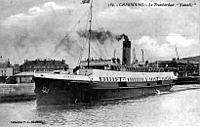
The Nomadic arrived in Cherbourg, France, on June 3, 1911. It immediately started its job of carrying passengers for the White Star Line.
Helping the Titanic
On April 10, 1912, the Nomadic carried 274 passengers to the Titanic for its first voyage. Among these passengers were famous people like New York millionaire John Jacob Astor IV and his wife Madeleine. Others included Sir Cosmo Duff-Gordon and his wife, Lucy, Lady Duff-Gordon, and the well-known American socialite Margaret Brown.
World War Service
During World War I, the French government used the Nomadic as an auxiliary minesweeper. It also helped transport American troops in Brest, France. After the war, it went back to its regular job. In 1927, it was sold but continued to work as a tender ship.
In 1934, the White Star Line merged with the Cunard Line. Also, the port at Cherbourg became larger, allowing big liners to dock directly. This meant the Nomadic was no longer needed for its original job. It was sold again and renamed Ingenieur Minard.
During World War II, the Nomadic was used again. On June 18, 1940, it helped evacuate people from Cherbourg. Later, the British Royal Navy used it as a place for sailors to live in Portsmouth harbor.
After the war, the Cherbourg port was badly damaged. Large ocean liners still could not dock there. So, the Nomadic was saved from being scrapped and returned to its tendering duties. It served famous liners like the Queen Mary and Queen Elizabeth. It finally stopped working on November 4, 1968.
Life as a Restaurant and Museum
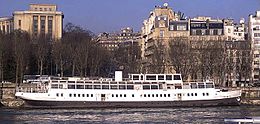
The Nomadic was unused for five years. Then, a person named Yvon Vincent bought it, saving it from being scrapped. He turned it into a floating restaurant and event venue. In October 1974, it moved to the Seine River in Paris.
The Nomadic even appeared briefly in James Cameron's 1997 film Titanic. By 1999, the restaurant business was having money problems. In 2002, the Paris harbor authorities took control of the ship. They removed some parts of its upper structure so it could be towed under the Seine's bridges. On April 1, 2002, it was towed from Paris to Le Havre.
After Yvon Vincent died in 2005, the authorities wanted to sell the ship. If no one bought it, it would be scrapped. People who loved history and ships started campaigns to raise money to buy the Nomadic. Many people, especially in Northern Ireland, supported these efforts. However, they could not raise enough money to buy the ship.
But the campaigns gained support from politicians and the government. On January 26, 2006, the Northern Ireland government bought the ship at an auction for €250,001.
The SS Nomadic left Le Havre to return to Belfast on July 12, 2006. It arrived near where it was built on July 18, 2006. The ship was carried on a special marine barge. Many people welcomed it back, including government officials.
Bringing the Nomadic Back to Life
The Northern Ireland government created a group called the Nomadic Charitable Trust (NCT) in December 2006. This group's job was to own the ship and manage its care and restoration. Their goal was to restore the Nomadic and open it to the public. They wanted it to be a key part of celebrating the Titanic's history.
In April 2015, the NCT gave ownership of the Nomadic to the Titanic Foundation. Now, the ship is managed by Titanic Belfast Nomadic Limited. It is part of the Titanic Belfast visitor attraction.
Another group, the Nomadic Preservation Society (NPS), was also started in 2006. They work with the NCT and other groups to help save the Nomadic. They raise money, do historical research, and promote the ship as a tourist attraction.
Restoring the Ship
A study estimated that restoring the Nomadic would cost about £7 million. The NCT has received over £6.5 million in funding from various groups. These include the UK Heritage Lottery Fund and the Northern Ireland Tourist Board.
In August 2008, the Nomadic was added to the National Register of Historic Vessels. This list includes other important ships like the Cutty Sark. This shows how historically important the Nomadic is.
In August 2009, the Nomadic was moved to Hamilton Graving Dock in Belfast. This dry dock, which is also a historic site, was partly fixed up. It is believed that the Nomadic was originally fitted out in this very dock. This dock is now the permanent home for the Nomadic.
By late 2009, the NCT had enough money to start major restoration work. In February 2010, they began cleaning and painting the steel hull to stop it from rusting.
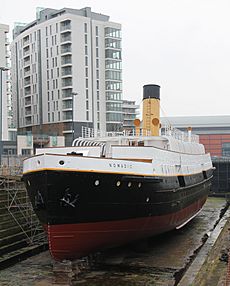
In February 2011, Harland and Wolff, the ship's original builders, were hired to repair and restore the steelwork. This brought back a 100-year connection with the ship. This work cost £2 million. It included rebuilding the missing bridge decks and painting the ship in its original White Star Line colors. These repairs were finished in February 2012. The ship is still not fully restored; for example, the front mast is still missing but will be added later.
The final part of the restoration involves fixing up the luxurious interior. This includes plaster panels and fancy woodwork. Original wooden panels from the Nomadic were bought from a French museum. These panels have been loaned to the NCT to be carefully restored and put back on the ship. This phase also includes restoring the historic Hamilton Graving Dock. The goal is to turn the dock area and the ship into a tourist attraction.
Nomadic's Lifeboats
The remaining lifeboat from the Nomadic is one of only two White Star Line lifeboats still existing in the world. The other is from the RMS Oceanic.
The Nomadic originally had two 6-meter (20-foot) lifeboats. Each could hold about 28 people. These were meant for up to 1,200 passengers and crew in an emergency. Later, life-rafts were added too.
The Nomadic's lifeboats were removed around October 1974 when the ship moved to Paris. They sat on the dockside for 13 years, getting damaged and having parts stolen.
In 1987, a deal was made to loan the two lifeboats to a museum in Cherbourg. The lifeboats were left outside, and over time, they became damaged and the wood rotted. Eventually, one lifeboat was too damaged to save and was burned.
Then, a historian found the remaining lifeboat. In 2007, it was bought from the museum. To bring it back to Belfast, a special support was built for the boat. It was then taken to Petticrew Marine. For the next five years, the boat hung from this support and slowly returned to its original shape. Money was also raised to restore the boat.
Once the boat was back in shape, work began to restore it. Missing wood was replaced, and missing parts were remade. The restoration used original materials, as required by the funding group. A new keel was made, and then the hull was repaired using original wood. The lifeboat's nameplate had been stolen, so a new one was made using old photographs.
As of 2014, the lifeboat has been structurally restored and painted in its original colors.
The lifeboat is now on display on the Queen Mary in Long Beach, California. It arrived there in June 2017 and is still there as of 2021.
Images for kids
-
The Nomadic photographed in the port of Cherbourg in 1911.
-
Nomadic as she appeared in 2000, docked on the Seine in Paris
-
Nomadic in March 2012, in Belfast, Northern Ireland painted in full White Star colors, after the first phase of restoration
See also
 In Spanish: SS Nomadic para niños
In Spanish: SS Nomadic para niños


